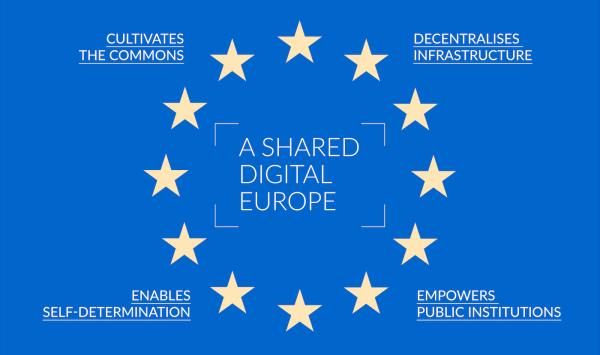Hidden messages in the European Strategy For Data
Not really hidden, actually.

Two months ago I presented the nine european data spaces of the new EU strategy for data. Today (*) I shortly comment another “Key Action” in that plan that is really “key”, in my opinion (emphasis mine):
“Invest in a High Impact project on European data spaces, encompassing data sharing architectures (including standards for data sharing, best practices, tools) and governance mechanisms, as well as the European federation of energy-efficient and trustworthy cloud infrastructures and related services, with a view to facilitating combined investments of €4-6 billion, of which the Commission could aim at investing €2 billion. First implementation phase foreseen for 2022; In the period 2021-2027, the Commission will invest in a High Impact Project on European data spaces and federated cloud infrastructures."
According to that announcement, this project will:
- fund infrastructures, data-sharing tools, architectures and governance mechanisms for thriving data-sharing and Artificial Intelligence ecosystems
- be based on the European federation (i.e. interconnection) of energy-efficient and trustworthy edge and cloud infrastructures.
- address the specific needs of industries in the EU… [in order to] support European companies and the public sector in their digital transformation.
- [be part of] a wider set of strategic EU investments in new technologies that the Commission will present in March 2020 as part of its industrial strategy. They concern in particular funding for edge computing, high-performance computing/quantum computing, cyber-security, low-power processors and 6G networks.
Other features and goals of this High Impact project on European data spaces
Concretely, the Commission intends to fund the establishment of EU-wide common, interoperable data spaces in strategic sectors. Such spaces aim at overcoming legal and technical barriers to data sharing across organisations, by combining the necessary tools and infrastructures and addressing issues of trust, for example by way of common rules developed for the space.
Investments may also cover the interconnection of existing computing capacities at national and European level, including High Performace Computing capacities.
Data and cloud infrastructures and services that provide the essential features of security, sustainability, interoperability and scalability [are] essential for European businesses to benefit from a complete value chain of data generation, processing, access and re-use.
The European Commission will foster synergies between the work on European cloud federation and Member States’ initiatives… to avoid multiplication of fragmented cloud federation and data-sharing initiatives, as the success of such an initiative would depend on pan-European participation and capacity to scale.
The only way this can work as declared…
Whether it was wanted or not, there is only one way to make all the concepts and intentions emphasized above really work as they are written. It is obvious, and not surprising at all, but it is useful to spell it out anyway:
Europe needs an EU-made cloud, running as much as possible on open, EU-designed processors (which is crucial, as I’ve said several times), and on software that, from top to bottom, only interoperates through really open, royalty free, communication protocols and file formats
On a side note… please notice that, while we haven’t even started to cut across the hype around 5G, there already are public funds allocated to the next season of that particular sitcom.
_(*) This post was drafted in April 2020, but only put online in August, because… my coronavirus reports, of course)